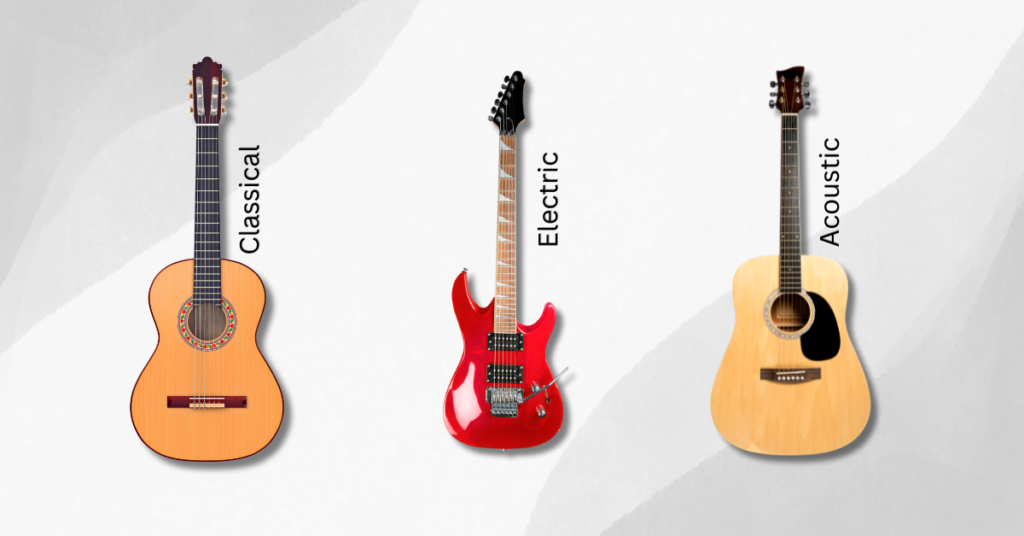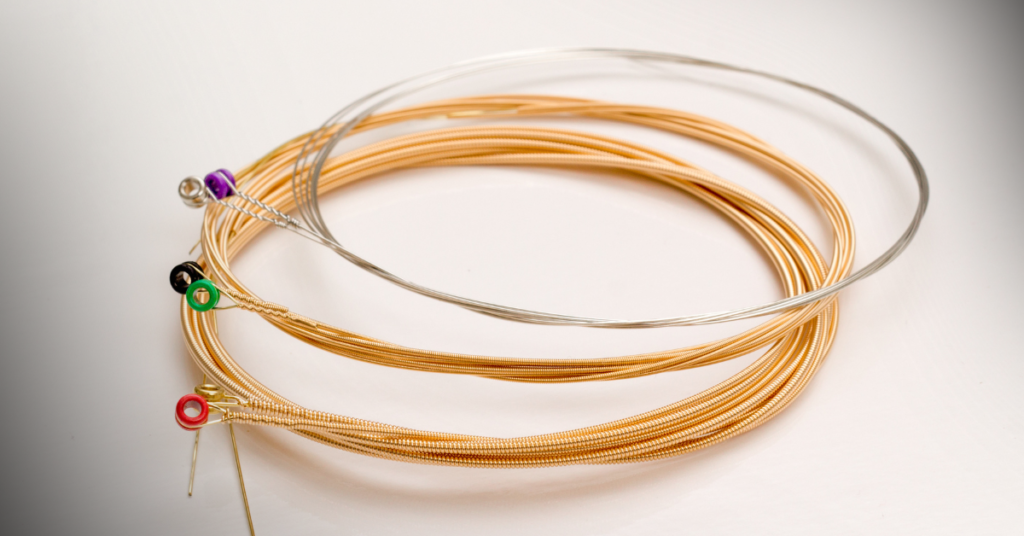So, you’ve got your dream guitar, and you’re ready to shred some solos or strum your heart out on some acoustic melodies, but wait… what about the strings? You may be thinking, “Strings are strings, right? Aren’t they all the same?” Well, let me stop you right there. Choosing the right set of guitar strings is way more important than most people realize. Your strings can alter the tone, playability, and even the overall feel of your instrument. So, let’s dive deep into the world of guitar strings and help you pick the perfect ones for your playing style.

Contents
- 1 Why Guitar Strings Matter More Than You Think
- 2 Breaking Down Guitar String Basics: What You Should Know
- 3 1. Guitar Type Matters: Acoustic vs. Electric vs. Classical
- 4 2. String Gauge: The Size Really Does Matter
- 5 3. Winding Styles: Roundwound vs. Flatwound vs. Half-Round
- 6 4. Materials: What Are Your Strings Made Of?
- 7 5. Your Playing Style Dictates Everything
- 8 6. Experimenting with Different String Types
- 9 7. How Often Should You Change Strings?
- 10 Conclusion: Stringing It All Together
- 10.1 1. What type of guitar strings should I use as a beginner?
- 10.2 2. How do I choose the right gauge for my guitar strings?
- 10.3 3. What’s the difference between acoustic and electric guitar strings?
- 10.4 4. What are coated guitar strings, and should I use them?
- 10.5 5. How often should I change my guitar strings?
- 10.6 6. What’s the difference between roundwound and flatwound strings?
- 10.7 7. Do guitar strings affect tone?
- 10.8 8. Can I use electric guitar strings on an acoustic guitar or vice versa?
- 10.9 9. What’s the best string material for acoustic guitars?
- 10.10 10. Should I use nylon strings on my steel-string guitar?
Why Guitar Strings Matter More Than You Think
If you’re new to guitar, figuring out which strings to buy can be overwhelming. Walk into any music store, and you’ll be greeted with a massive wall of strings—different brands, gauges, coatings, and materials. It feels like string overload. And it’s easy to wonder: do they really make that much of a difference? Absolutely.
The type of strings you use impacts the tone your guitar produces, how it feels when you play, and even how long your strings last. Whether you’re jamming on an electric, strumming an acoustic, or plucking a classical guitar, picking the right strings will take your playing to the next level.
Breaking Down Guitar String Basics: What You Should Know
Before we jump into the details, let’s get the basics out of the way. A standard six-string guitar (the most common type) has six strings that follow this order, starting from the thickest to the thinnest: E-A-D-G-B-E. The thickest string is your low E, and the thinnest is your high E.
To help you remember the order, here’s a handy rhyme: “Eddie Ate Dynamite, Good Bye Eddie.” It’s quirky, but it works!
Now that we’ve got the basics covered, let’s jump into the important stuff—how to choose the right strings.
1. Guitar Type Matters: Acoustic vs. Electric vs. Classical
First things first: What kind of guitar are you playing? Each guitar type needs different strings.

Electric Guitar Strings: Typically made from steel or nickel, these strings aim to provide a clean, amplified sound through your guitar pickups. They’re generally thinner than acoustic strings and come in various gauges (we’ll get to that in a minute).
Acoustic Guitar Strings: For acoustics, the strings need to resonate through the hollow body of the guitar to produce sound. Acoustic strings are usually made of bronze or phosphor bronze and are thicker to produce a fuller sound. Because you don’t have pickups to amplify the sound, the thicker string gauges help to produce louder tones.
Classical Guitar Strings: These strings, typically made of nylon, produce a soft, mellow sound. Classical guitar strings are easier on the fingers, making them ideal for beginners. However, never put steel strings on a classical guitar; the neck isn’t built to handle that kind of tension, and it might cause damage.
2. String Gauge: The Size Really Does Matter
The term “gauge” refers to the thickness of the strings, usually measured in thousandths of an inch. This is where you start making some decisions based on your playing style.
Light Gauge Strings (Thin Strings): These are easier to bend and require less finger strength. If you enjoy playing solos or doing a lot of bending (think of bluesy licks or soaring metal leads), thinner strings like a 9-gauge (for electric) or 10-gauge (for acoustic) might be perfect for you. However, they tend to break more easily if you’re heavy-handed.
Medium Gauge Strings: This is the “goldilocks zone” of string gauges. If you’re a versatile player who likes both lead and rhythm, medium-gauge strings are a balanced choice. For electric guitars, 10-46 gauge is quite popular. For acoustic, 12-53 gauge gives a nice balance of tone and playability.
Heavy Gauge Strings (Thick Strings): These are for the players who want a thicker tone, especially for playing rhythm, heavy riffs, or using alternate tunings like drop D. Heavy gauge strings, like 11s or 12s for electric, and 13s for acoustic, offer a rich, warm sound, but they’re harder to bend and require more finger strength. Metalheads and blues players often gravitate toward heavier strings because of the deeper sound.

Keep in mind, the heavier the strings, the more tension they put on your guitar neck, which can affect its playability and setup. And yes, this also applies to bass guitars—those beefy strings can range from 0.045″ to 0.105” in thickness.
3. Winding Styles: Roundwound vs. Flatwound vs. Half-Round
You might’ve heard terms like “roundwound” and “flatwound” thrown around. These terms explain the wrapping of the thicker strings (the low E, A, and D) around the core wire.
Roundwound Strings: These are the most common type of guitar string, where a round wire is wrapped around the core. They have a brighter sound but are also prone to more finger noise when sliding across the strings. Most electric and acoustic guitars use roundwound strings.
Flatwound Strings: If you want a smoother sound with less finger squeak, try flatwound strings. These are popular in jazz because they produce a warmer, mellower tone. They’re also easier on the fingers because they have a smooth texture.
Half-Round Strings: These sit somewhere between roundwound and flatwound. They have the bright sound of a roundwound, with less squeak. These are rare but worth trying if you want a hybrid experience.
4. Materials: What Are Your Strings Made Of?
The material of your guitar strings can drastically affect your sound. Let’s break it down:
Nickel-Plated Steel: The most common material for electric guitar strings. These strings offer a balanced tone that’s not too bright and not too warm.
Phosphor Bronze: Popular for acoustic guitars, phosphor bronze strings give a bright, bell-like tone with a bit of warmth. These strings are ideal for fingerstyle players or singer-songwriters who require their guitar to stand out from the background.
Nylon: These strings, used for classical guitars, have a soft, mellow tone. Great for fingerpicking or flamenco-style playing.
Coated Strings: Coated strings are a newer invention where a thin layer of polymer protects the strings from dirt, grime, and sweat, extending their lifespan. The tradeoff is that coated strings can sound a little duller compared to their uncoated counterparts. If you’re someone whose strings corrode quickly, though, coated strings could be a great investment.
5. Your Playing Style Dictates Everything
Ultimately, your playing style will be the biggest factor in choosing the right strings. Here’s a quick breakdown:
Lead Players: You’ll probably want lighter strings that are easy to bend and allow you to play fast licks and solos.
Rhythm Players: If you focus more on chords and heavy strumming, opt for medium or heavy gauge strings to give you a fuller sound.
Fingerstyle: For fingerpicking, you’ll want lighter strings that respond well to gentle plucking, especially on an acoustic guitar.
6. Experimenting with Different String Types
No matter what, the only way to find your perfect strings is by experimenting. Try different brands, materials, gauges, and coatings until you find the set that feels and sounds just right for your playing style. Some guitarists stick with the same strings their entire life, while others are constantly switching things up to keep their sound fresh.
7. How Often Should You Change Strings?
How often you change your strings varies depending on how much you play and what type of strings you use. Regular playing may require replacing uncoated strings every 1-2 months. Coated strings, on the other hand, can last up to 6 months or more before they start to sound dull.
Conclusion: Stringing It All Together
Choosing the right guitar strings is an art form in itself. It’s all about matching the right gauge, material, and winding style to your guitar, as well as, most importantly, your playing style. Whether you’re just starting or you’ve been playing for years, finding the perfect strings will elevate your sound and help you connect with your guitar in a whole new way.
So, next time you’re in your local music store, don’t just grab the first pack of strings you see—take a moment to think about what will best complement your sound. With the right setup, you’re not just playing your guitar; you’re making music.
1. What type of guitar strings should I use as a beginner?
As a beginner, it’s usually best to start with light gauge strings. For acoustic guitars, 0.010 to 0.012 gauge strings work well, while for electric guitars, 0.009 to 0.010 gauge is easier to play. Nylon strings are ideal for classical guitars, offering a softer feel.
2. How do I choose the right gauge for my guitar strings?
The right gauge depends on your playing style and comfort level. Lighter strings are easier on the fingers and great for beginners or players who prefer fingerpicking. Heavier gauge strings offer more volume and sustain but can be harder to press down.
3. What’s the difference between acoustic and electric guitar strings?
Acoustic guitar strings are usually made of bronze or phosphor bronze and are designed for louder, fuller sound without amplification. Electric guitar strings are often made of nickel or steel and are crafted to work with pickups for amplified sound.
4. What are coated guitar strings, and should I use them?
Coated strings are treated with a thin polymer coating to prevent corrosion and extend their lifespan. If you play frequently or live in a humid environment, coated strings can save you from having to change strings as often.
5. How often should I change my guitar strings?
It depends on how much you play and your personal preference. For beginners, changing strings every 3-4 months is a good practice. More advanced players or those who play daily might need to change them more often.
6. What’s the difference between roundwound and flatwound strings?
Roundwound strings are more common and offer a brighter tone with more texture under your fingers. Flatwound strings have a smoother surface, producing a warmer, mellow sound and are often preferred by jazz or blues players.
7. Do guitar strings affect tone?
Yes, the type, gauge, and material of your guitar strings significantly impact your tone. Lighter strings produce a brighter, thinner tone, while heavier strings offer a fuller, richer sound.
8. Can I use electric guitar strings on an acoustic guitar or vice versa?
While you technically can, it’s not recommended. Electric guitar strings won’t resonate as well on an acoustic guitar, and acoustic strings can put too much tension on an electric guitar, potentially causing damage.
9. What’s the best string material for acoustic guitars?
Bronze and phosphor bronze strings are the most popular for acoustic guitars. Phosphor bronze offers a warmer, more balanced tone, while regular bronze strings give a bright, punchy sound.
10. Should I use nylon strings on my steel-string guitar?
No, nylon strings are designed for classical or flamenco guitars and won’t work well on a steel-string acoustic or electric guitar. They have different tension requirements and might damage your guitar if used incorrectly.











